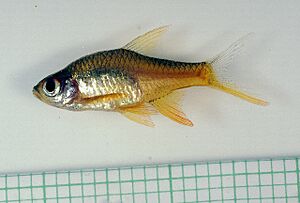Rasboroides vaterifloris facts for kids
Quick facts for kids Rasboroides vaterifloris |
|
|---|---|
 |
|
| Conservation status | |
| Scientific classification | |
| Synonyms | |
|
The Pearly Rasbora (scientific name: Rasboroides vaterifloris) is a small, colorful freshwater fish. It is also known as the Vateria flower rasbora or Fire rasbora. This fish is a type of cyprinid, which means it's related to minnows and carps.
Pearly Rasboras are special because they are endemic to Sri Lanka. This means they are found naturally only in Sri Lanka and nowhere else in the world.
Contents
About the Pearly Rasbora
Pearly Rasboras are quite small. They can grow up to about 4 centimeters (about 1.5 inches) long. They are popular in the aquarium trade because of their beautiful colors.
Where it Lives
This fish likes to live in shallow, clear streams. These streams usually have slow-moving water and are shaded by trees. They prefer areas where the bottom is silty and there are lots of fallen leaves. The leaf debris provides good hiding spots and food.
What it Eats
The Pearly Rasbora's diet is quite simple. They mostly eat detritus, which is tiny bits of dead plants and animals. They also enjoy eating small insects that fall into the water from land.
Its Family and History
For a long time, scientists thought that Rasboroides vaterifloris was the only species in its group. They also believed it lived in many different rivers.
New Discoveries
In 2013, a study showed that the Pearly Rasbora actually lives only in the Kalu River basin in Sri Lanka. Other similar fish species were found in different river basins.
Later, in 2018, another big study looked closely at these fish. Scientists used different methods, like measuring their bodies and looking at their DNA. They found that one of the species thought to be different, Rasboroides nigromarginatus, was actually the same as R. vaterifloris.
This discovery means that the Pearly Rasbora's home range within the Kalu River basin is a bit larger than first thought.
Conservation Status
Even with this slightly larger range, the Pearly Rasbora is still considered a threatened species. This means its numbers are not as high as they used to be, and it needs protection. Another related species, Rasboroides pallidus, is more widespread and not as threatened.


